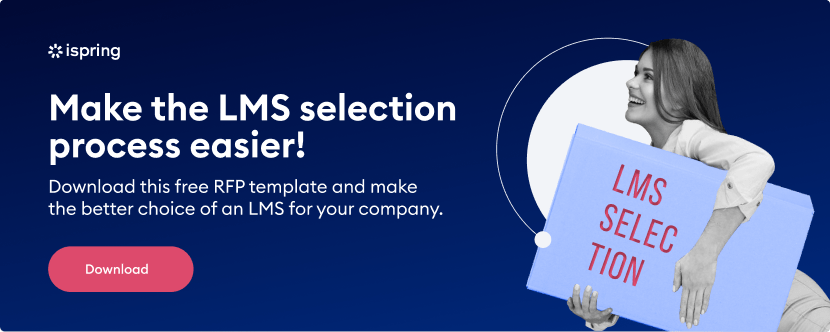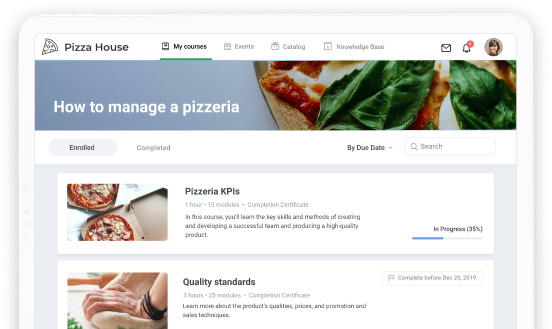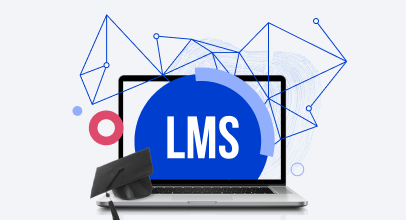How to Write a Crystal Clear RFP When Choosing an LMS

Typically, we write requirements for creating something from scratch: a website, an app, or a design. But sometimes requirements are prepared for choosing a ready-made but complex and expensive product, such as a learning management system. This list of requirements is called a request for proposal, or RFP.
Over the years, the iSpring team has received dozens of RFP variations, from one-page lists of essential features to documents in hundreds of pages full of diagrams. Based on them, we’ve prepared a guide on how to create an RFP that will help you choose the best LMS for your business needs.
What is a Request for Proposal (RFP)?
A Request for Proposal (RFP) is a document that companies create and send to potential LMS vendors when they need to launch an eLearning project. It outlines details on the company, its project, and the expectations regarding the solution they need. If vendors suppose they’re capable of meeting your demands, they send proposals; the company compares the offered solutions and selects the most suitable one.
Why Does a Client Need a Request for Proposal?
Spending time on composing a detailed request may seem like an unnecessary workload, because good vendors do their best to gather as much information about clients and their projects as possible and offer a suitable solution anyway. Still, there are five reasons to take the time and develop an RFP.
1. Define what you really need
The RFP specifies what exactly you’d like to achieve with an LMS and puts it in writing. Having clear goals defined before the start of the project, you’ll be able to evaluate the effectiveness of the project after the launch: have you managed to get the expected results, or not? Just giving a random solution a try and waiting for it to sink or swim is a bad strategy when making a decision for thousands of dollars.
2. Prioritize
To make your way from point A to point B, you can drive a Mercedes as well as a horse cart; both will carry you to the destination. So when you start an eLearning project, you need to understand which features are required and which ones are nice to have, what you’re ready to pay for, and which features you can give up for economy.
3. Determine the limits
It’s better to inform vendors of all the critical moments before they get started with a presentation. These include deadlines, budget, number of users, and the need to use a specific technology, for example, on-premise installation. If the deadline for a full-scale launch of eLearning is in two months, it makes no sense to waste time listening to the presentation of solutions that will take up to six months to deploy.
4. Make your way through the crowd
An Amazon search shows over 100,000 results for “t-shirt”: for men, for women, for children, even for cats. It’s impossible to have a look at each of them. The good news is that there are only about 500 LMS providers, but even so, you still need a filter to cut out the irrelevant solutions.
5. Get exactly what you need
This is possible when you manage to minimize the difference between the views of the client and the service provider. An RFP helps to find gaps in understanding the task and drag to light all the essential details that can make a difference in implementation, final cost, and the very solution you choose.
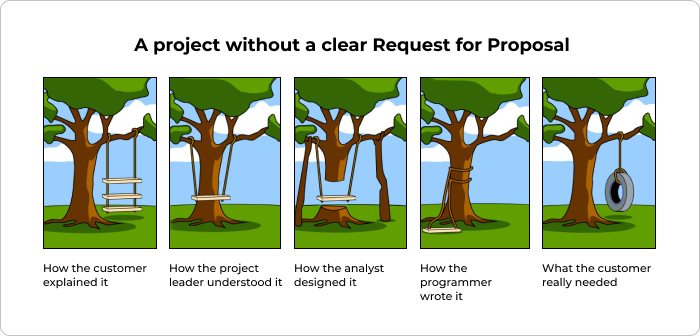
A project without a clear Request for Proposal
The Anatomy of an LMS Request for Proposal
The chances of seeing two identical RFPs are the same as meeting two people with identical fingerprints. Still, the structure of any good RFPs is similar to another, as there are general sections that will be of use in any case.
1. Project summary
This is a one-page description of a project that outlines key data: the inputs are this and that, the goal is such and such, the supposed solution is the following.
Nobody would read a hundred pages to get to the bottom of it. In summary, you specify the main requirements for the LMS you’d like to buy. If vendors see their solution works for you and they’re interested in the project, they study the details and start working on the proposal. If not, well, at least you haven’t spent much time explaining.
A strict deadline is a serious filter for vendors that allows you to avoid vain negotiations with providers who can’t fit into your framework. Specify the selection schedule and the date when you expect to get started with eLearning.
Also, name the person from your company who will lead the project and will answer additional questions.
What you shouldn’t do is describe the history and accomplishments of your company in every detail. Instead, provide a link to a presentation or to the relevant website section; usually, that’s enough.
Example:
Bakery No. 3 is in need of a new learning management system (LMS). We would like to invite your company to participate in the selection process and to submit a proposal. Project Summary: Bakery No. 3 produces 90 types of bread, pastries, and confections. There are over 350 employees in the company: food technologists, dough-makers, bakers, operators, and sales reps — they all need to be trained. Right now, the training is conducted with BrightMind LMS, but we’ve decided to move to a more modern platform. The tasks we need to accomplish with an LMS:
Expected training metrics:
Key requirements:
Proposal Process Schedule: July 12, 2021: the deadline for submitting proposals. July 13 – July 22, 2021: presentations, live product demos. July 26 – August 20, 2021: hands-on trials. August 21 – September 1, 2021: decision making. We expect to be able to export users and content from the previous LMS by November and to launch pilot training on the new platform in December 2021. John Phillips, the head of the training department, will answer any additional questions regarding the project. Tel: +0 ХХХ ХХ ХХ Email: j.phillips@bn3.com |
2. About the project
Tell vendors more about your training project and how you plan to work with the LMS. This is a large section, so it’s better to divide the information into logical blocks for the sake of convenience.
2.1. Inputs
Indicate the initial data that you know at the start of the project:
- How many users are you going to train?
- How many active users do you expect per day or per month?
- How many users will simultaneously use the system?
- How many courses do you already have?
- What materials do you plan to upload and what are they?
Example:
Users Number of users at the start of the project: 350 We plan to create learner accounts for all employees of the bakery. Starting in September, there is usually an influx of new employees who need training. Once a year, we conduct a mass assessment for all the employees; they will be actively using the system for two weeks. Content Now we have 35 SCORM courses, and several videos and PowerPoint presentations. The total size of the files is 72 GB. After the launch of the new platform, we plan to add new training materials every three months. We also would like to use the LMS as a storage space for documents: instructions, product catalog, and contracts. |
2.2. User Roles
LMS users may have different permission levels. By assigning each user a specific role, you set boundaries: what they can do in the system, which files they can see, and which they can’t. For example, administrators can add users, upload courses, assign courses to the learners, and track their progress. The learners are often confused by excessive features, so they can only take the courses which are available to them.
As a rule, the variants and the number of user roles depend on the organizational structure of the company. In a small company, one person often combines several roles: sets up the portal, adds users, and uploads the content. In this case, two user roles — administrator and learner — are quite enough. A larger company may need five or more user roles.
Let’s take a simplified diagram of a chain enterprise as an example.
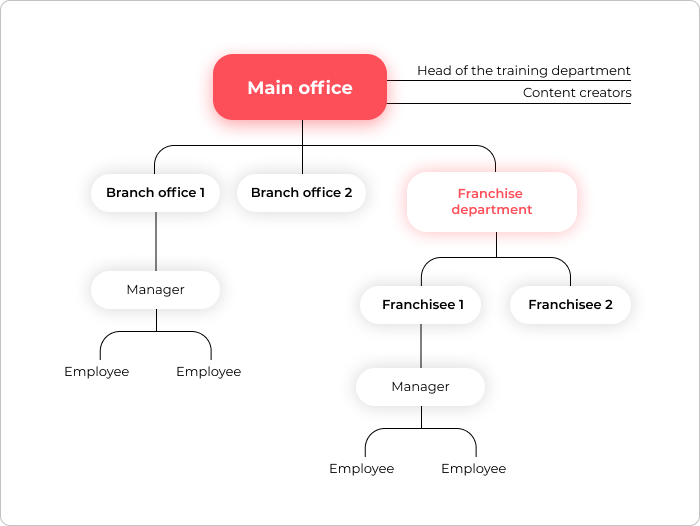
A simplified diagram of a chain enterprise
Here are the user roles they might need:
- Account Owner (the head of the training department in the diagram) has the fullest access to the LMS capabilities: he manages the platform settings, sees financial information, and can view any files and create organizations within the organization (for example, separate the franchise department from the owned branches).
- Administrator. The head of the training department has assistants with full access rights, save for changing a pricing plan or deleting the company’s account. They set up user groups, and manage learning paths and content.
- Organization Administrator. Each branch is headed by a manager. He manages users, assigns courses to employees, and keeps track of statistics within his organization, but he can’t have a look at these things in another branch.
- Author (or Publisher, or Content Creator). This person uploads new courses and updates the old ones. For instance, corporate trainers, instructional designers, and methodologists usually have author permissions.
- User (or Learner). An employee who simply takes courses and tests.
Think about the scenarios for using an LMS in your company, and what types of users you’ll need.
Example:
User Roles We expect that the selected LMS will support at least four types of user roles:
One person can take up any number of roles. |
2.3. Features
If you are planning to buy an out-of-the-box or partially customized solution, it’s better to describe what the platform should do, not how exactly it should be done.
One problem can have several solutions. The optimal strategy is to clarify the usage scenario for a requested feature, wait for the vendors’ response, and together with your technical specialists, select the most suitable option.
Example:
Feature | Scenario |
Group chats | We’d like an administrator to be able to send a message to a user group or all learners in an organization. |
The other possible solution is to describe the scenarios and attach another document where a vendor can check the boxes next to the list of features you’d like to have. On the iSpring blog, there’s a comprehensive guide on LMS feature requirements.
2.4. Integrations and Compatibility
Enlist the programs, software, and services you plan to use in conjunction with an eLearning platform. Imagine you spent $50,000 to buy the LMS and found out that it can’t recognize the format of your e-courses. Unpleasant surprise, indeed. Therefore, if you already use any services, say, an authoring tool or a service for video conferencing, decide whether any integrations are vital or you can do without them.
3. About the vendor
In the previous sections, you mainly talked about yourself: what your company’s tasks and limits are, and what you expect from the LMS. The purpose of this section is to get acquainted with a potential LMS provider.
Most likely you’re going to send the RFP to several companies at the same time. In order not to waste time on processing disparate responses, offer your structure to the vendor. It can be the following:
3.1. Summary of the proposed solution
Ask vendors to prepare a one-page summary of the proposed solution, so that it is convenient for you to catch the key points. As a rule, decisions on purchasing an LMS are made collectively, so the summary will simplify the task for you, your colleagues, and stakeholders.
3.2. About the company
What to pay attention to:
- How long has the company been on the market?
- How many people are there in the team?
- Who are the customers?
- Are there any prestigious awards?
3.3. About the platform
- Technical requirements.
- Details on features, functionality, and limitations.
- Additional features and customization that can be made if necessary.
- Possibility to start small or run a pilot project and then scale.
- Data security policy.
3.4. Compliance with the requested functionality
Although we’ve already mentioned that it’s better to describe the desired result, not the way to achieve it, it doesn’t always work that way in practice. When you engage engineers and security specialists to develop the RFP, you’ll likely get a long list of specific requirements that are either must-have or nice to have.
Transfer this list to Excel or Google Sheets and attach a link to the RFP. The client manager will go through all the points and mark if the LMS meets each requirement or not. Using such a table saves a lot of time because all you have to do is compare the responses of the vendors.
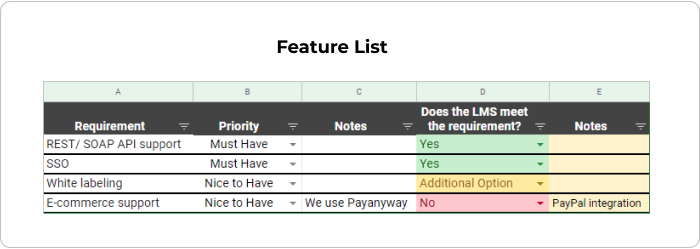
Excel and Google Sheets allow you to filter the data. It’s convenient, especially when you have a long list of requirements.
3.5. Implementation plan
- What are the stages of implementation?
- How long will each stage take?
- What work will the vendor do?
- What work will be required on your part?
3.6. Proposed budget
The cost of an eLearning project consists of five components:
- The cost of the LMS (here’s a guide on various pricing models);
- Implementation costs;
- Setup training;
- Technical support;
- Maintenance and updates.
Ask vendors to specify the total sum and detail the expense items.
3.7. References
Feel free to ask for some case studies, especially if a vendor has experience working with companies from your industry. But the most useful practice for decision making is to ask for direct contacts from two or three companies that already use the LMS, so you can find out how the LMS works in practical situations.
Usually, it will take some time for a vendor to get in touch with their client and get permission to share their contact information with a prospect, but if they’re willing to do it, it’s a good sign that you can trust them.
To Sum Up
- Take the time to work out an RFP once, and save a lot of time listening to irrelevant presentations and marketing pitches.
- Keep a clear structure and describe your requirements, from general to specific.
- If you share LMS usage scenarios in the RFP, you’ll have a better chance of finding a suitable solution in less time.
- Outline your critical expectations and limitations in the RFP.
- Prepare a list of detailed technical requirements in a separate document (Excel or Google Spreadsheets) so that the vendor can mark each feature as present or absent.
If you need to consult about your situation and decide on LMS requirements for your company, contact iSpring support specialists, and they will be there for you.
